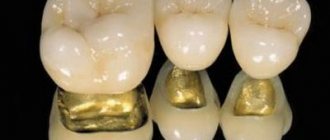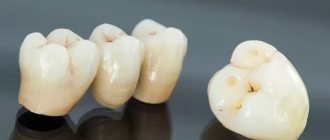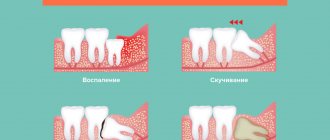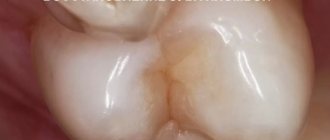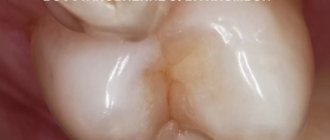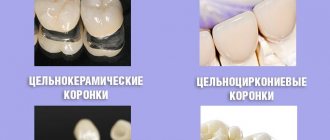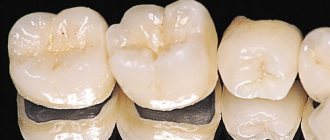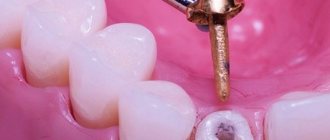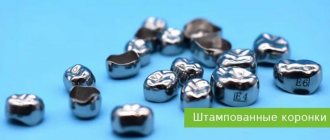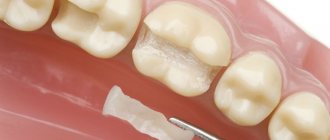Today, dentists have a lot of options for prosthetics - restoring a damaged or missing tooth. One of the most effective solutions is metal ceramics - it is reliable and aesthetic. With its help, you can restore one or more teeth, and the structure is supported by implants or the patient’s own teeth.
Metal-ceramics are orthopedic structures - crowns and bridges, which are made by spraying or casting ceramics onto a metal base or frame. This method of prosthetics is in great demand, since the material used to restore the shape and function of the tooth does not cause allergic reactions. Metal-ceramic prosthetics are more often performed for the masticatory region, since in this case the strength of the structure is a priority, but this does not at all deprive artificial teeth of their aesthetics. Such designs closely replicate the structure and color of natural teeth.
Structure and types
Metal-ceramic dental prosthetics got its name due to the structure of the structures: inside it has a cast metal frame with a thickness of 0.3-0.5 mm. The material of manufacture is cobalt or nickel-chromium alloys. In some cases, alloys of precious metals - platinum or gold, palladium and others in different proportions - can be used. Crowns are divided into corresponding types according to this parameter.
The use of gold has an undeniable advantage - due to the natural yellowness of the precious metal, it is possible to achieve a natural shade of the structure, which is especially in demand when it is necessary to replace the front teeth.
The metal frame is covered with ceramics. The base is veneered using manual layer-by-layer application of ceramic mass. The structure is fired in a kiln after each layer is applied - this allows for the best connection between metal and ceramics.
As for the structure of the structure, the following types of metal-ceramics in dental prosthetics are distinguished:
- Actually single crowns. They are widely used to restore teeth in the lateral zone when they are more than ⅔ destroyed.
- Bridges. They are designed to restore several missing teeth in a row. The most reliable design is considered to be two crowns for supporting teeth and 2 artificial teeth between them.
Sequence of dental procedures
When choosing metal-ceramic crowns, clients of Aesculapius dentistry can expect a painless two-stage procedure. Specialists provide treatment over several appointments. The sequence of manipulations is as follows:
- Turning of the support unit. The doctor prepares the basis for further fixation of the crown. If the root system is damaged, it is removed. Our dentists are more focused on pulp preservation. If possible, the depulpation procedure is not performed.
- Fixation of a plastic crown. The dentist installs a temporary structure on the ground base. It allows you to avoid discomfort while eating and communicating with people.
- Collection of data for crown manufacturing. The doctor makes impressions during the first appointment. The dental technician receives the information received, after which he begins manufacturing the metal-ceramic crown. First, a specialist forms a metal frame, after which he applies a layer of ceramics. Without fail, it recreates the natural healthy color of the patient’s enamel. Production time - no more than 14 days.
- Installation of a permanent crown. After removing the temporary structure, metal ceramics are fixed. Upon completion of the manipulation, the crown is covered with a special glaze, which makes it identical to the natural adjacent teeth.
The duration of adaptation to a new artificial unit is no more than 2 weeks.
Advantages and disadvantages of metal ceramics
Compliance with manufacturing standards and installation technology almost completely eliminates possible harm from installing the structure. The use of modern materials eliminates the release of toxic substances, but it is important to remember that an individual reaction may occur.
The ceramics itself, used in the manufacture of artificial teeth, does not cause allergies - a possible reaction is provoked by the metals in the frame of the structure. For example, chromium-nickel alloys can provoke an allergic reaction to nickel, and the use of base metals under the influence of saliva can be susceptible to oxidation reactions. Symptoms of an allergic reaction may include:
- burning in the mouth;
- metallic taste;
- swelling of the gums in the area of contact of soft tissues with the crown.
If such symptoms occur, it is important to consult a dentist - you will probably need to replace the structure with an all-ceramic crown or use another prosthetic method.
Other disadvantages include the possibility of exposing the metal frame in the event of receding gums. It is worth noting that structures made of zirconium dioxide are not subject to this phenomenon. In addition, the technology of metal-ceramic dental prosthetics involves grinding the tooth under a crown and removing the pulp in many cases, which is also a disadvantage.
The advantages of metal ceramics include high strength and long service life. Today, metal-ceramics are used for both single crowns and bridges - it is in demand when it is necessary to replace teeth with a significant chewing load. The frame made of aluminum dioxide or zirconium is strong enough, so the dentures can withstand heavy loads.
A long service life - 10-12 years for alloys of base metals and about 15 in the case of using a gold-platinum alloy - is a key advantage of the designs. This is only relevant for those prostheses that are made using individual casts. It is also important to follow the doctor’s recommendations for care - in this case, the prosthesis will last as long as it should. This is necessary because one of the common reasons for premature crown removal is the development of secondary caries at the junction of natural and artificial tissues, so it is very important to visit a doctor in a timely manner.
To summarize, we can say that the advantages of metal ceramics are as follows:
- comfort of wearing structures;
- functionality - function is restored due to the flawless modeling of masticatory hillocks;
- strength;
- long service life;
- acceptable aesthetics;
- biological compatibility - in the absence of allergic reactions to metals;
- the possibility of prosthetics for both anterior and chewing teeth;
- shade fastness - ceramics are not susceptible to the action of dyes;
- comparative cheapness;
- the possibility of restoring the structure without removing it in the event of minor chips.
FAQ:
– Good afternoon, tell me, I recently had metal-ceramic crowns installed, and after that I started having severe headaches. Plus I experience constant discomfort when talking and chewing food. What is the reason for this and can it be fixed?
Hello. Without a preliminary examination, it is difficult to assess your situation, but most likely, during prosthetics, the correct closure of the teeth (occlusion), as well as the height of the bite, was disrupted. As can be seen from your explanations, the dental system cannot get used to these changes (hence all the symptoms you listed). In order to correct the situation, you need to remove the crowns and re-prosthetics. You can get more detailed information by making an appointment with an orthopedic dentist.
– Is it possible to put metal-ceramics on the front teeth?
Metal-ceramics may be an option for restoring anterior teeth. Everything directly depends on the clinical situation. If aesthetics is important or the condition of the teeth does not allow teeth to be restored with metal-ceramics, taking into account all the wishes of the patient and the condition of the teeth, other options for tooth restoration can be considered, for example, metal-free ceramics (veneers, or ceramic crowns based on zirconium dioxide)
– What does the cost of a metal-ceramic speaker consist of?
The cost of metal-ceramic crowns does not include the work of a specialist; the following services are also paid additionally: panoramic photographs of teeth, taking impressions, local anesthesia. You should check with the specialist performing the treatment about the cost and number of additional services. In many clinics, treatment can be provided on credit. It would be a good idea to ask about the warranty.
Color of metal-ceramic structures
Separately, I would like to note the advantage of metal-ceramics, due to which many patients prefer it - ceramics, which is used for the manufacture of structures, allows you to imitate the shade and structure of your own tooth enamel. Therefore, the prosthetic tooth is similar to the patient’s natural teeth. The shade is selected according to the Vita scale - the selected color will remain that way throughout its entire service life, since ceramics are not subject to darkening and do not tend to absorb dyes from drinks and food.
The only thing that can change the shade of an artificial tooth is pigmented plaque, which is easily removed with professional oral cleaning.
Treatment of chewing teeth
The main task of the posterior organs of the oral cavity is a high-quality solution to functional problems. Metal-ceramic crowns ideally meet the requirements for reliability and strength. The top layer is of sufficient thickness and is well connected to the base, so it can withstand the entire level of chewing load. The risks of chipping are minimal. The ceramic coating can only be destroyed intentionally. The design can withstand the load due to its slight relief. The mentioned tubercles correspond 100% to the individual characteristics of the oral cavity, as they are made to order.
Indications for metal-ceramic prosthetics
A doctor may recommend this method of tooth restoration for the following indications:
- severe tooth decay as a result of caries or injury - the impossibility of restoring it with fillings;
- anomalies of dental development that disrupt the function and aesthetics of the dentition;
- the absence of 2 or more teeth in a row and the presence of supporting teeth on the sides of the dentition defect (cermet bridges can be used here);
- inability or unwillingness to use other prosthetic methods.
List of indications and restrictions
Our dentists offer to install metal-ceramic crowns to patients from Moscow and the region for the following purposes:
- prevention of enamel abrasion;
- installation of supports for removable dentures, implants;
- elimination of aesthetic and functional defects 2–3/ of a number of units;
- restoration of color parameters, shape of teeth after caries, taking medications, gumboil, etc.
Contraindications to treatment with metal-ceramic structures are:
- some malocclusions;
- individual intolerance by the body to metal supports;
- severe form of periodontitis;
- defects of the coronal part of the supporting unit;
- absence of more than 4 “native” organs of the oral cavity;
- living pulp;
- abrasion of pathological enamel.
When working with young patients (up to 16 years), Aesculapius dentists use other methods of restorative treatment.
Contraindications
This prosthetic method cannot be used for:
- periodontal disease;
- bruxism (in this case, it is important to first correct the condition or cure the disease, otherwise the structure may damage the teeth that come into contact with the crown when the jaws close);
- malocclusion;
- allergic reactions to metals and alloys;
- shortened crown parts of teeth;
- periodontitis is a temporary contraindication that requires preliminary treatment of the disease.
Metal ceramics are a worthy basis for making crowns
Teeth are important organs that perform chewing and aesthetic functions. Unfortunately, with age, a person’s smile loses its former attractiveness, and diseases arise in the oral cavity that negatively affect well-being and personal comfort. Destruction of the coronal part is the most common problem. We offer to solve it within the walls of our dental clinic. Aesculapius specialists will conduct free diagnostics and offer the best corrective techniques. Treatment with metal-ceramic crowns is one of these. The installation of replacement structures is carried out in case of destruction of the masticatory or anterior units resulting from injury or disease. The metal-ceramic crown is reliable due to its stable, durable base and aesthetically perfect outer part. The price of such dental correction starts from 8 thousand rubles.
Stages of metal-ceramic prosthetics
The process of dental prosthetics with metal-ceramics can be divided into two large stages: preparation and prosthetics itself. An initial consultation with an orthopedic dentist allows you to determine the scope of work to be done, assess the condition of the oral cavity, and discuss options for restoring the shape and function of the tooth. According to the drawn up treatment plan, the patient is sent for diagnostics.
Preparing teeth for metal-ceramic prosthetics consists of the following:
- Performing X-ray diagnostics. It allows you to determine the absence of inflammatory changes in the periodontal tissues and evaluate the quality of filling if endodontic treatment was previously carried out (the pulp was removed and the root canals were sealed). If the canals are sealed poorly - not completely or, conversely, with the filling material extending beyond the apex of the root, the doctor will unseal them and carry out repeated treatment.
- Professional teeth cleaning and caries treatment, replacing old fillings, if necessary.
- Depulpation - removal of a nerve. If the damaged tooth has not been depulped previously, the doctor performs this procedure in the following cases:
- the presence of inflammation at the apex of the tooth, pulpitis;
- the need for prosthetic replacement of a single-rooted tooth - the pulp must be removed.
If prosthetics of a multi-rooted chewing tooth is required, the pulp can be left intact - but the final decision on this is made by the dentist, taking into account the individual characteristics of the condition of the oral cavity and the structure of the dental system.
In order to determine how dental prosthetics are done with metal-ceramics, it is necessary to take into account the degree of tooth destruction. Thus, a stump inlay for a metal-ceramic crown is made in cases where the tooth’s own crown is destroyed by more than half - at the root, or if only thin walls remain.
And if a larger volume of tissue is preserved, a pin can be used - it is screwed into the root canal, and an artificial crown is installed on it.
The actual stages of dental prosthetics with metal-ceramics are as follows:
- Tooth preparation - grinding. The question of whether teeth are anesthetized during metal-ceramic prosthetics, as a rule, is not raised - of course, the specialist performs preliminary anesthesia to eliminate the patient’s discomfort during the procedure.
The doctor grinds the teeth and then takes impressions - this is necessary for the further production of artificial structures according to individual parameters. Turning is carried out in one of two ways:
- with a ledge - the orthopedic dentist forms a circular ledge along the lower edge, which protects the gums from contact with the metal frame and reduces the likelihood of possible complications - swelling, irritation from contact of tissues with metal. This method also allows the use of metal ceramics with shoulder mass - it is applied in the area of the ledge to increase the aesthetics of the structure, and makes it possible to hide a strip of metal that can be visible through the ceramics at the base of the structure. Turning with a shoulder also makes it possible to extend the life of the structure;
- without a ledge - this method is outdated, so it is rarely used today. It has significant disadvantages - it does not provide enough space for a crown and can disrupt the contours of the gums. A space is formed between the structure and the gum tissue, in which dental plaque accumulates, and the edge of the denture looks quite unaesthetic. The design may cause irritation to soft tissues.
When contacting the clinic, find out how dental prosthetics are done with metal-ceramics - using the first or second method. This will avoid possible troubles with further wearing of the structure.
- Making an impression. Using impression material, the doctor takes impressions of the ground teeth. In order to accurately reproduce the parameters of the teeth, the gums are shifted using rings or retraction threads.
- Installation of a temporary crown. Due to the fact that the production of a permanent structure takes a certain time - about 1-2 weeks, the doctor installs a temporary crown made of plastic. This is necessary to protect the tooth core from food and saliva, as well as to ensure aesthetics. While the patient wears a temporary crown, a metal frame is made in the dental laboratory, onto which ceramic mass is subsequently applied layer by layer.
- After the permanent crown is made, it is installed using temporary cement after preliminary fitting of the structure. If it does not cause discomfort, the doctor will fix the crown using other, permanent materials.
Advantages and disadvantages
A metal-ceramic crown with shoulder mass in SPB has numerous advantages:
- durability;
- tight and precise fit to the ledge;
- strengthening the edge of the prosthesis;
- eliminating the risk of developing inflammation in the mucous membrane;
- preventing blackening of the gums in the neck of the tooth.
Thanks to the shoulder mass, the metal strip on the tooth is not noticeable at all. It is impossible to distinguish a denture from a natural dentition.
Most dentists provide installation services for such prosthetic structures. The doctor performing the installation procedure must have special knowledge and experience. The manufacturing technology of the product is complex and requires extreme care and skill from the dental technician. Another disadvantage is the high cost of prosthetic products.
How is a crown made?
Many patients wonder how long it takes to have metal-ceramic dental prosthetics. It is important to understand here that the procedures for preparing the teeth and the installation itself are carried out quite quickly, but the manufacture of the structure takes longer. As a rule, 1-2 weeks are enough to make a metal-ceramic crown. Based on the casts created, specialists make a plaster model - it is cast according to the impression after a preliminary assessment of its quality.
Then a dental laboratory specialist models a framework for metal-ceramics using wax. The finished frame is fixed on a plaster model and sent to an orthopedic doctor so that he can try it on in the patient’s mouth.
Then ceramic mass is applied to the frame. Before this is done, it is fired in a kiln and sandblasted - this allows for better adhesion of the metal and the ceramic mass.
The opaque is applied first - this is an opaque composition, then the structure is covered with a dentin layer (more transparent), and then with an enamel layer. This technology makes it possible to recreate the natural appearance of a tooth, taking into account the individual characteristics of the color of the enamel of your own teeth.
After the patient has tried on the design, glazing and final firing are carried out - then the crown is installed.
Metal ceramics in Dentistry at Amazing Prices
Qualified dentists at the clinic on Amurskaya perform prosthetics with metal-ceramic crowns using high-quality consumables (metal alloys and durable porcelain coatings) and high-precision equipment.
The process of making and installing crowns requires 2 to 4 visits to the doctor. After preparatory measures (preparation of the abutment tooth), an impression is taken from both jaws, on the basis of which a plaster model of the human dentition is made in a dental laboratory. Then, based on the model, the metal frame of the crown is recreated, on which the fissure pits, tubercles and other anatomical features of the tooth are displayed. After fitting, this metal base is covered with ceramic mass and fired.
Thanks to the painstaking work of our specialists, metal-ceramic crowns are durable and provide patients with a beautiful smile for many years.
Features of caring for metal ceramics
Everyday hygiene measures do not differ from normal procedures - it is important to brush your teeth twice a day, and also rinse your mouth, if possible, after eating.
Cleaning the teeth should be carried out as follows: using sweeping movements, you need to go over all the teeth in the direction from the gums to the cutting edge. You should not ignore the use of dental floss, or better yet, an irrigator.
You can clean metal ceramics in the same way as regular teeth - a toothbrush should be purchased in accordance with the doctor’s recommendations (the degree of stiffness of the bristles is determined by individual characteristics), the toothpaste can also be selected based on your needs.
Remember that it is better to protect metal-ceramic structures from mechanical damage. It is not recommended to bite into hard foods - this can result in cracks and chips, and subsequent breakage of the prosthesis.
Correction of anterior teeth
Metal-ceramic crowns are distinguished by increased aesthetic properties, so they are installed on visible parts of the oral cavity. They solve functional problems by eliminating psychological discomfort during communication. During treatment, our specialists adhere to the following rules:
- horizontal arrangement of the lower part of the crowns parallel to the level of the pupils;
- determination of the joint line of the front teeth strictly in the center of the face;
- symmetry, correspondence of shapes, sizes, colors of replacement units in relation to each other.
Upon completion of the installation of metal-ceramics, the treating specialist corrects the bite using “carbon paper” - articulating paper. This avoids mechanical damage to the cutting edge in the future.
Warranty for metal ceramics
A good dental clinic provides a guarantee for metal-ceramic dentures - its period, as a rule, is less than the service life of the structure. If the prosthesis breaks before the warranty period expires, the clinic provides restoration or replacement services free of charge.
Restoration is carried out in case of mechanical damage to the crown - for example, chips. In this case, the prosthodontist assesses the extent of the problem and determines whether the framework of the structure is exposed. Restoration of a small chip that does not expose metal is carried out using composite materials. However, restoration when the frame is exposed may be impossible; the optimal solution here would be to remove the structure and re-prosthetics. In order to prevent unpleasant situations (chipping, crown loss), it is important to promptly replace metal-ceramics after their service life has expired.
It is important to make a choice regarding the type of metal-ceramic structure, taking into account how long you plan to wear the structure. Of course, the best can be considered to be made from a gold-platinum alloy; its service life reaches 15 years, and zirconium dioxide crowns can last even longer with proper care. However, the cost of such solutions will vary.
Our guarantees
The duration of wearing a metal-ceramic crown is influenced by its cost and proper oral care. Why? The type of base plays a role. Elements made from noble metals last 3 years or more. Traditional “budget” prostheses made of metal-ceramics regularly perform their assigned functions for 12 years. The length of service also depends on the patient - how he monitors his oral health. Mandatory activities:
- rinsing after meals;
- brushing teeth 2 times a day;
- preventive examination by the attending physician once every six months.
We issue a guarantee certificate for the work performed. Every Moscow guest can learn more about the service and receive a professional assessment of oral health absolutely free.
Sign up for a consultation at a convenient time, also pay attention to the current discounts presented on the main page of the site.
